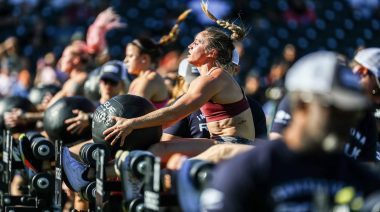The 2014 CrossFit Games began yesterday and we’re keeping a close eye on the competition – including our own Patrick McCarty. Patrick is competing in the Games as a masters athlete for the third time.
In order to help you all join in this annual celebration of CrossFit, we are analyzing the WODs and giving tips on how to adapt them. We’ll be issuing a challenge or two, as well! Today we start by bringing you all the Masters Workouts in one place, accompanied by our recommendations on how to scale and strategize.
The 2014 CrossFit Games Masters Workouts
7/22: DEADLIFT LADDER
1-rep deadlift every 30 seconds with progressively heavier barbells
As soon as the athlete cannot lift the bar, he or she moves to a lighter bar and does as many reps within the thirty-second lifting window to count in the event of a tie.
100 point event
Men 40-49: 325 / 355 / 385 / 415 / 435 / 455 / 475 / 495 / 515 / 535 lb.
Women 40-49: 195 / 215 / 235 / 255 / 275 / 295 / 315 / 335 / 355 / 375 lb.
Men 50-59: 295 / 325 / 355 / 385 / 405 / 425 / 445 / 455 / 465 / 475 lb.
Women 50-59: 185 / 205 / 225 / 245 / 265 / 285 / 305 / 315 / 325 /345 lb.
Men 60+: 265 / 295 / 315 / 335 / 355 / 375 / 395 / 415 / 435 / 455 lb.
Women 60+: 135 / 155 / 175 / 195 / 215 / 235 / 255 / 275 / 295 / 315 lb.
Ideas for scaling this workout:
If you’ve been deadlifting for some time now, you probably have a good idea of how much weight you can pull. It looks to me like they started the loads at about 60-70% of expected 1RM for the group and went to about 115-120% of the expected 1RM for the group.
Keeping in mind that these are some very fit people driven to put it all on the line, you might want to start and end somewhat lighter, take more than thirty seconds between lifts, and scrap the max reps altogether. All of this after warming up thoroughly, of course. Failure of form should mean the end of your effort.
If you are new to deadlifting, may we suggest that, instead of going heavy and possibly doing a lot of damage to your body, you instead choose a version of the deadlift (or similar exercise) that limits the load significantly or tests the posterior chain another way, such as the single-leg deadlift, pistol, or the back bridge-up. The deadlift alternatives video below features Al Kavadlo.
If you decide to give the single-leg deadlift a try, here’s Josh Henkin with a detailed tutorial on it, including several progressions. You can watch the video below or watch the video and read the entire article here.
7/22: MAX DISTANCE
Handstand walk for maximum distance in the specified number of attempts with a two-minute time limit.
100 point event
Men and Women 40-49: Max distance handstand walk in 1 attempt
Men and Women 50-59: Max distance handstand walk in 2 attempts
Men and Women 60+: Max distance overhead walking lunge (50lb/30lb ball)
I think the scaling here is well done: if you cannot do handstand walks, the overhead walking lunge mimics the requirements for core and shoulder stability safely. Instead of a medicine ball, you might choose a barbell, kettlebells, or dumbbells for resistance and to more accurately reflect the hand position of a handstand.
If you would like to learn to handstand walk, Pulse Beat Fit has a nine-part handstand walking tutorial video series by Dusty Hyland of Dogtown CrossFit. Here’s episode one:
7/22: SLED SPRINT
100-yard sled drag with a two-minute time limit
100 point event
As I watched several heats of sled drags, it became clear that an all-out sprint from go might not be the best strategy. The number of lead changes after the halfway mark was crazy. Whether it was a failure to utilize muscles evenly (relying too much on either glutes and hamstrings or quads), a conditioning problem (not likely), or something else, those who were fast but steady seemed to do well compared to those who might have underestimated what 100 yards would feel like.
If you don’t have access to a sled, you could always push a car around the neighborhood. It’s going to be heavy, but the angle is about the same.
7/22: RUN ROPE
Five rounds for time of 400m run and rope climb(s) with a sixteen-minute time limit
100 point event
Men and Women 40-49: 2 legless rope climbs
Men and Women 50-59: 2 rope climbs
Men and Women 60+: 1 rope climb
A classic upper-lower split. The fact that it’s five rounds has to be taken into consideration from the start. While the upper body will have plenty of recovery time during the run, the cardiovascular system never gets any rest.
The first idea that comes to mind for scaling this workout is to eliminate the time limit and hold a pace that you find challenging. Add your 400m time and your rope climb time and hold to that split for all five rounds.
Work the standard scaling techniques for rope climbs, hardest to easiest: legless – with legs – multiple partial climbs – pulling yourself up in a reverse plank from the floor to standing with the rope – offset bodyweight rows with the rope alternating top hand.
7/23: 2007
1000m row followed by five rounds of pull ups and push jerks, all for time, with a sixteen-minute time limit.
100 point event
Men and Women 40-49:
Row 1,000 meters
then, 5 rounds of:
- 25 pull-ups
- 7 push jerks 135lb/85lb
Men and Women 50-59:
Row 1,000 meters
5 rounds of:
- 20 pull-ups
- 7 push jerks 125lb/75lb
Men and Women 60+:
Row 1,000 meters
5 rounds of:
- 15 pull-ups
- 7 push jerks 115lb/ 65lb
Rowing is all about knowing your split time. Just as a triathlete doesn’t start a race as fast as possible, neither should you sprint 1,000m and expect to perform well afterward. Setting the damper correctly and using good rowing technique are as important as being in great condition. Rather than scale this section, most athletes will be better off working on technique. Pulse Beat Fit has an entire series on becoming a better, more efficient, and faster rower.
As far as pull ups go, if you haven’t got them yet, there are good options for you:
- Jumping pull ups, possibly with a slower negative phase
- Inverted Rows on a bar or rings
- Seated pull ups with legs supported
- Heavy band pull downs
Typically, bands have been used, but they are not the ideal scaling method to actually build you up to real pull ups. You can read why, and what to do instead, here.
To scale the push jerks, use lighter weight on the barbell or use kettlebells, dumbbells, or a sandbag. The sandbag, especially, will allow using less weight with relative safety and maximal muscle activation. If you aren’t familiar with the push jerk, substitute another less ballistic and technical movement such as the push press or press.
7/23: MEDBALL BURPEE
21-15-9 reps for time of:
- Medicine-ball cleans (over the shoulder)
- Burpees
with an eleven-minute time limit
100 point event
Men 40-49: 80-lb. ball
Women 40-49: 50-lb. ball
Men 50-59: 70-lb. ball
Women 50-59: 40-lb. ball
Men 60+: 50-lb. ball
Women 60+: 30-lb. ball
Not much to say here, really. If you’re going to give this one a shot, be careful to keep your movements clean and precise, both for shoulder health and because getting no-repped, especially by a gym mate, makes a black place grow in your soul.
The “official” Pulse Beat Fit CrossFit Games compliant burpee video:
7/24: DOWN & BACK CHIPPER
Box jumps or step-overs, toes to bar, and dips, for time, with a 21-minute time limit
100 point event
Men and Women 40-49:
For time:
50 box jumps (24 / 20 in.)
25 toes-to-bar
50 wall-ball shots (20 / 14 lb.)
25 ring dips
50 wall-ball shots (20 / 14 lb.)
25 toes-to-bar
50 box jumps (24 / 20 in.)
Men 50-59 and Women 50-59:
For time:
40 box jumps (24 / 20 in.)
20 toes-to-bar
40 wall-ball shots (20 / 14 lb.)
20 ring dips
40 wall-ball shots (20 / 14 lb.)
20 toes-to-bar
40 box jumps (24 / 20 in.)
Men 60+ and Women 60+:
For time:
40 step-overs 24″/20″
20 toes-to-bar
40 wall-ball shots 14lb/10lb
20 bar dips
40 wall-ball shots 14lb/10lb
20 toes-to-bar
40 step-overs 24″/20″
The workouts and movements seem to be getting simpler, albeit no easier, as the week goes on. The scaling on this one is pretty simple, as is the approach – know yourself well enough to choose movements you can perform with precision for the entire number of reps in the entire workout, not the number of reps in any one set.
If you find the movements you chose to be too easy when you start the workout, take solace in the fact that you will soon be cursing that measly 20″ box. Keep in mind that you could also scale during the workout, though scoring becomes problematic at that point.
Competing with your gym mates, or yourself, for time without the spectre of a time-limit hanging over your head may also help you to stay safe while “enjoying” this workout.
Box jumps might seem like the most basic movement ever, but there are finer points to everything. If you’d like to improve your performance and longevity on this movement, check out this video from Pulse Beat Fit and David Ayres.
Photos courtesy of CrossFit, Inc.






